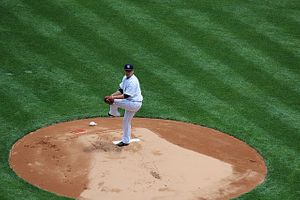Masahiro Tanaka came to America like a streaking comet, suddenly and brightly.
And then just like that, he’s gone – most likely for the rest of this baseball season and maybe even most of the next.
Tanaka joined the New York Yankees last winter after a bidding war that made him the most expensive Japanese import in Major League Baseball history. And the right-handed pitcher immediately set out to prove he’s worthy of the team’s $175 million investment.
He wasted no time in becoming the Yankees’ ace, winning his first six decisions as the team won 12 of his first 14 starts. Tanaka ran his record to 11-1 by mid-June and had the best ERA in the American League at 1.99.
But then signs of trouble began to show. He would lose three of his next four starts while his ERA ballooned to 2.51. As it turned out, it wasn’t so much that the MLB batters have figured him out, but his elbow was troubling him.
After a 5-3 loss to Cleveland on July 8, the Yankees finally shut him down when they discovered a torn ligament in his pitching elbow. The team doctors have opted to prescribe rest and rehab for the time being, with an optimistic timetable of a September return. But more realistically, his season is over, and the possibility of Tommy John surgery looms.
A spirited debate has ensued in the U.S. about whether the Yankees misused Tanaka. In his 18 starts, he’s gone at least six innings in each. His 129 1/3 innings pitched placed him in the top 10 in MLB and would’ve been on pace to exceed the highest workload during any of his seven seasons pitching for the Rakuten Eagles in Japan.
But he’s never had any arm trouble in the past and no one really foresaw his being shut down because of an injury.
“It was kind of a shocker,” Daily Yomiuri’s John Gibson told The Diplomat. “When he was going through the wooing period he checked out fine in all the medical areas. We never saw any warning signs with Ma-kun, the same was true with Yu Darvish.”
Gibson, an American journalist who’s covered Japanese baseball since 1990 and also writes a baseball blog about the NPB at OneWorldSports.com, added that a former Japanese pitcher told him an interesting theory that had not been previously pondered: The ball used in Japanese baseball is lighter than an American baseball.
But Gibson scoffed at the notion that Tanaka’s injury was caused by his frequent use of the split-finger fastball. A devastating pitch that comes out of the pitcher’s hand looking like a fastball only to take a nasty dive toward the dirt as it reaches the plate, the splitter has been the most potent weapon in Tanaka’s arsenal in Japan but especially in MLB, where he’s made numerous batters looking foolish flailing away at the unhittable pitch.
Combining that with other pitches in his repertoire, Tanaka had been nothing short of sensational in his rookie MLB season, single-handedly keeping the Yankees in the pennant race. His 12 victories tied for the most in the majors and, had he not been injured, Tanaka would’ve been the first Japanese pitcher to start in an MLB All-Star Game, which was played on Tuesday.
His success might’ve surprised some Americans, but in Japan, where his every move has been chronicled by the media and followed by legions of fans, this was the Tanaka they’ve known all along.
“He just bears down. He has a knack for knowing what the batters are trying to do and use that against them, and that was in a league where he knows everybody,” Gibson said. “I guess the surprise is that he was able to do that in the States even though he doesn’t know them that well. But one aspect is the over-aggressive swings of MLB players and he uses that against them.”
Unfortunately, no one will be seeing Tanaka plying his craft anytime soon. And with his absence, the Yankees’ championship hopes likely evaporated as well. He was the fourth of the team’s five original starting pitchers in 2014 to go down with an injury, with Japanese pitcher Hiroki Kuroda being the only exception.
The Yankees must take a long view on Tanaka’s health – after all, they signed the 25-year-old to a seven-year contract. If his elbow is not properly healed through rehab, he’ll need to have the Tommy John surgery that would sideline him for 12-18 months.
For his part, Tanaka issued a public apology to the team and its fans, a gesture so unusual in American sports that he instantly won many admirers for his class and dignity.
“I want to apologize to the Yankees organization, my teammates and our fans for not being able to help during this time,” Tanaka said in a statement Friday. “I accept this injury as a challenge, but I promise to do everything I can to overcome this setback and return to the mound as soon as possible.”

































